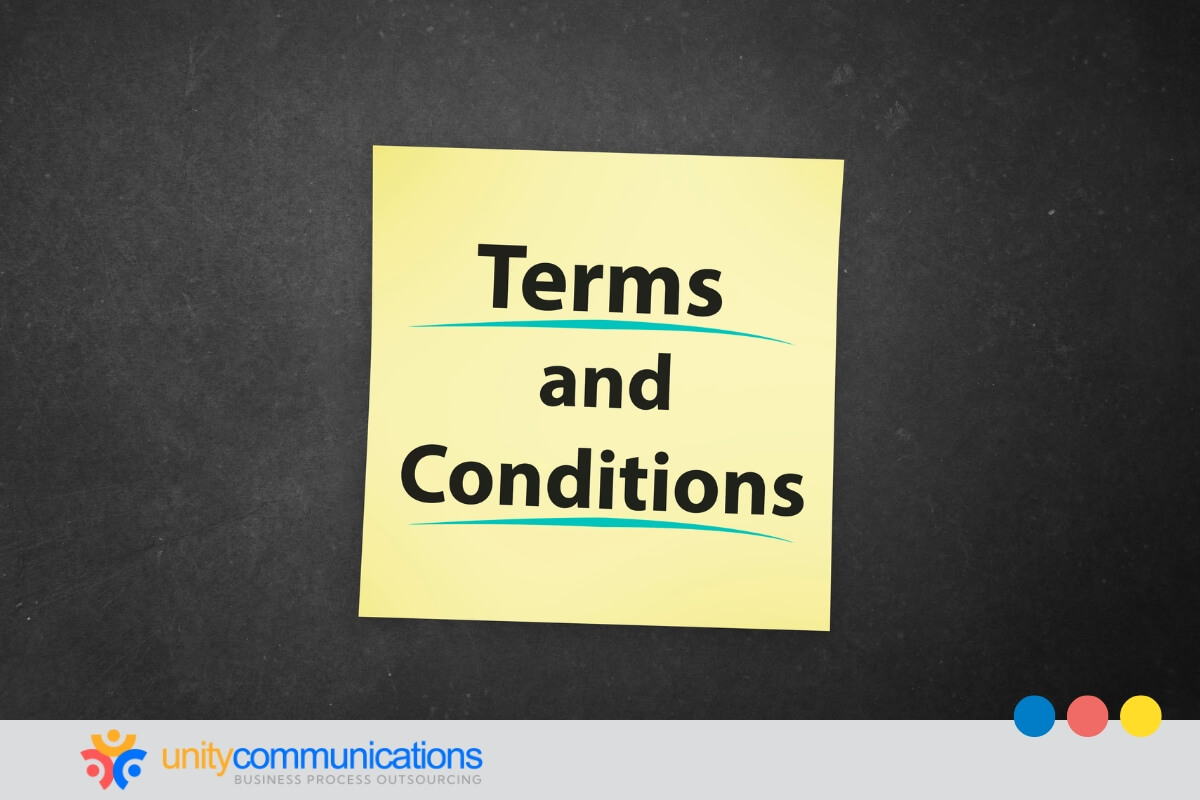Table of Contents
Working with multiple service providers can streamline operations and increase flexibility. However, it complicates vendor management, data integration, and workflow accountability.
The legal aspects of multi-vendor contracts become even more critical in business process outsourcing (BPO). Overlapping responsibilities and service levels can lead to disputes or compliance issues. Understanding these nuances protects your business and fosters smooth vendor collaboration.
This article focuses on multi-vendor outsourcing contracts, ranging from scope to dispute resolution mechanisms and metrics. Read on to learn how to clarify these agreements and minimize legal and operational risks.
10 factors that shape the legal aspects of multi-vendor contracts

Not all multi-vendor relationships involve outsourcing. For example, a company might use several software providers for in-house operations, such as Salesforce for customer relationship management (CRM) and Zoom for communication, without assigning any processes to an external provider.
However, in most cases, the approach fits the definition of BPO. For example, you might hire one outsourcing company to manage payroll processing and another to handle multilingual customer support.
Handing off certain BPO functions to particular teams provides many benefits. These include maximizing external expertise, reducing operating costs, and mitigating risks. However, complex partnerships can introduce coordination, integration, and legal issues.
To succeed, all BPO operations must align with your strategic objectives by considering the following legal aspects of multi-vendor contracts:
1. Contract scope and service levels
Investments in third-party outsourcing are on the rise. About 80% of executives intend to sustain or boost their spending. As you rely on more vendors for specialized tasks, it’s crucial to clearly define each agreement’s scope and service levels. It prevents overlap, confusion, and responsibility gaps.
Each contract should specify deliverables, timelines, and performance metrics tailored to that vendor’s role. Service-level agreements (SLAs) must be measurable, enforceable, and aligned to maintain workflow harmony.
A well-defined scope keeps expectations transparent and holds each provider accountable. It avoids inconsistent services, delays, and unresolved issues.
2. Governing law, jurisdiction, and dispute resolution
In a multi-vendor environment, selecting the right governing law, jurisdiction, and dispute resolution mechanisms can help manage conflicts efficiently and reduce legal risk:
- A governing law can define how parties must interpret the contract.
- Jurisdiction specifies where to resolve disputes.
- Dispute resolution clauses outline how to handle conflicts (e.g., negotiation, mediation, arbitration, and litigation).
For example, a U.S.-based company working with Philippine providers might designate New York law as the governing law. Arbitration in Singapore could be a dispute resolution method.
These factors create a neutral legal framework while requiring the Philippine vendor to comply with local labor and data privacy laws. Similarly, the U.S. company remains bound by any region-specific legal obligations.
Standardizing dispute resolution terms across vendors promotes consistency, avoids confusion, and streamlines handling disagreements. Clear procedures, timelines, and legal frameworks prevent costly delays and unfavorable rulings. They also maintain trust and operational continuity when issues arise.
3. Intellectual property (IP) rights management
Another essential legal aspect of multi-vendor contracts is IP management. According to the IP Commission, IP theft costs the U.S. economy an estimated $225 billion to $600 billion annually. This underscores the growing need for strong IP protections, particularly in complex and interconnected business environments.
Clear agreements prevent disputes when managing IP rights in a multi-vendor environment. For example, if two vendors build a platform together, a clear contract protects your ownership of the final product. Each outlines who holds the assets during engagement, particularly when multiple parties contribute to a single project.
Defining licensing terms, usage rights, and transfer clauses safeguards your proprietary tools, content, and systems. Without these protections, vendors could potentially claim rights to your innovations. A solid IP framework upholds legal clarity and ensures your business retains control over its valuable intellectual assets.
4. Confidentiality and data security clauses
With the average data breach cost of over $4 million, protecting sensitive information has never been more critical in multi-vendor outsourcing. Data flows across multiple systems and providers. This increases the risk of exposure and complicates consistent security enforcement.
Each vendor contract should clearly define what qualifies as confidential data and establish detailed responsibilities for its handling, storage, and transfer. For example, if outsourcing customer service, the contract should specify the encryption of customer names, contact details, and purchase histories at rest or in transit.
The clauses should comply with relevant data protection laws depending on your industry and location. Examples include the General Data Protection Regulation (GDPR) or the Health Insurance Portability and Accountability Act of 1996 (HIPAA).
Without these protections, the risk of data exposure and its high costs can significantly threaten your business, including financial losses and reputational damage.
5. Liability and indemnity provisions
Another legal aspect of multi-vendor contracts is liability and indemnity provisions. They define how to share risks between your business and each vendor in case of loss, breach, or service failure. They also outline the extent of each party’s financial responsibility and when indemnification applies.
Suppose a vendor’s system is hacked and client data is exposed. The contract might require the BPO provider to cover legal fees, notification costs, and regulatory fines resulting from the breach.
This avoids finger-pointing when issues arise in a multi-vendor setup. Carefully negotiated caps on liability and exclusions balance protection and fairness. A strong indemnity framework helps safeguard your business from unexpected legal and financial exposure across all vendor relationships.
6. Termination conditions and exit strategies
Termination clauses and exit strategies provide a clear roadmap for ending vendor relationships without disrupting business operations. Each contract can specify the grounds for termination, such as breach of contract, non-performance, or mutual agreement, and the required notice period.
As one of the legal aspects of multi-vendor contracts, exit strategies must include detailed transition plans to prevent service gaps or data loss. These provisions protect your business from being locked into unfavorable agreements or left vulnerable during vendor transitions.
A well-planned exit clause fosters continuity and flexibility. It reduces risk when changing or ending partnerships.
7. Performance metrics and monitoring
Performance metrics and monitoring determine whether each vendor delivers as promised. Contracts can include measurable key performance indicators (KPIs) tailored to each vendor’s services, such as the following:
- Service uptime (%) measures the percentage of time a system or service is operational and available. It is crucial for IT, cloud, and infrastructure vendors.
- Response time tracks how quickly a vendor responds to service requests, incidents, or customer inquiries. This is essential for customer support or managed service providers.
- Issue resolution time determines how long a vendor takes to resolve reported problems for timely service recovery.
- Accuracy rate assesses the percentage of tasks or deliverables completed without error. This metric is ideal for data entry, payroll, or finance outsourcing.
- Compliance rate evaluates how well the vendor adheres to industry regulations and contract-specific requirements.
Regular reporting and performance reviews help identify issues early, drive accountability, and support benchmarking and continuous improvement. Aligned metrics also help maintain high-quality service standards and transparency throughout the partnerships.
8. Renewal terms and conditions
Renewal terms and conditions define how to extend contracts beyond the initial vendor agreement period. These clauses specify notice periods for renewal, any changes in pricing or scope of work, and conditions to be met for renewal.
Coordinating renewal dates and terms in a multi-vendor environment helps maintain continuity and avoids service disruptions. Clear renewal policies also give your business leverage to define the terms or explore alternative providers.
9. Subcontracting and third-party involvement
These clauses clarify whether vendors can delegate tasks to other providers and under what conditions. These provisions help maintain control over quality and compliance by requiring prior approval or notification of subcontractors.
Managing third-party relationships becomes critical in a multi-vendor context to avoid hidden risks and strengthen accountability. Contracts can also measure subcontractors’ adherence to the same terms, especially regarding confidentiality and performance standards.
Clear rules around subcontracting protect your business from unexpected liabilities and service inconsistencies.
The bottom line

Handling the legal aspects of multi-vendor contracts is crucial for businesses looking to optimize their outsourcing strategies and minimize risks.
Understanding the complexities of contract scope, governing law, IP, and liability fosters smoother collaboration and strengthens vendor accountability. By mastering these key areas, companies can confidently manage multiple partnerships and drive successful BPO outcomes.
If you want to learn more about how to streamline your multi-vendor contracts and protect your business, let’s connect.




